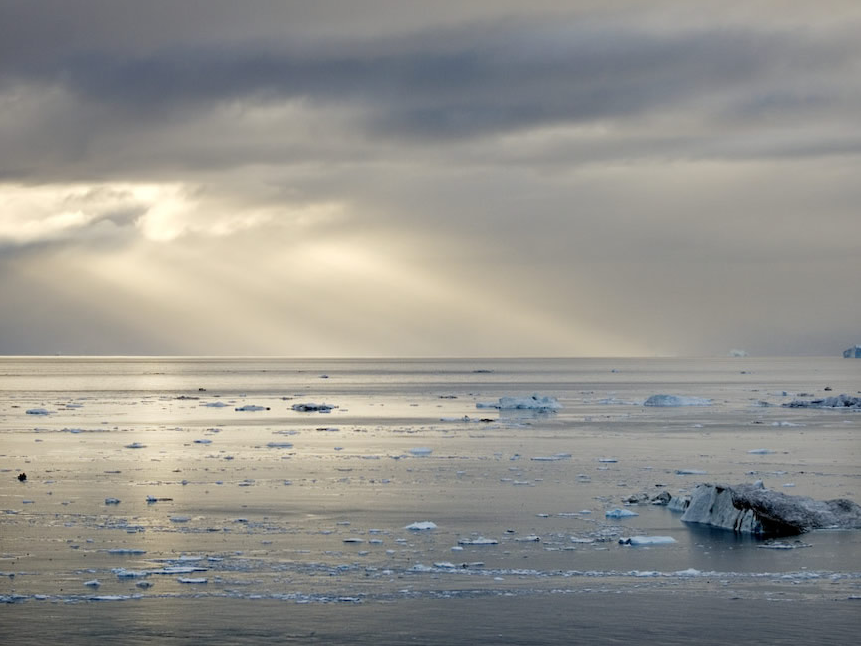Disko Rays
Disko Rays: A Phenomenon in the Arctic Sky
Disko Rays, also known as crepuscular rays or sunbeams, are a mesmerizing atmospheric optical phenomenon that can be observed in the Arctic region. This natural spectacle occurs when parallel rays of sunlight stream through gaps in clouds or between other objects, creating a captivating display of light and shadow. Disko Bay, located on Greenland's West Coast, provides a stunning backdrop for these radiant beams to illuminate the sky.
Disko Bay has a rich historical significance, serving as the final port of call for numerous early sailing ship expeditions that ventured into the Arctic in search of the North West Passage. These intrepid explorers would brave treacherous waters, crossing Baffin Bay and entering Lancaster Sound, only to find themselves trapped in ice for extended periods, sometimes up to a year. Today, however, due to climate change, the passage is becoming increasingly ice-free.
The appearance of Disko Rays is a result of the interaction between sunlight and atmospheric particles such as dust, water droplets, or ice crystals. When the sun is low on the horizon, its rays travel through more of the Earth's atmosphere, scattering off these particles and creating a visible cone of light. As the sunlight passes through openings in the clouds or objects on the ground, it casts shadows and reveals the rays' path, giving rise to the ethereal Disko Rays.
To fully appreciate the beauty of Disko Rays, it is best to observe them during sunrise or sunset when the angle of the sun is lower. During these times, the rays must pass through a greater portion of the atmosphere, resulting in more scattering and a more pronounced display. The contrast between the illuminated rays and the darkened surroundings enhances the visual impact of this phenomenon.
Disko Rays are not limited to just one location; they can be observed in various parts of the world under suitable atmospheric conditions. However, the Arctic's unique combination of pristine air, dramatic landscapes, and the interplay of sunlight and ice make Disko Bay an ideal setting for witnessing this awe-inspiring spectacle. The vast expanse of icebergs, fjords, and glaciers in Disko Bay adds an extra layer of grandeur to the already stunning display of rays piercing through the sky.
In addition to their aesthetic appeal, Disko Rays also serve as a reminder of the Earth's intricate atmospheric processes. These rays provide valuable insights into the behavior of light in our atmosphere, allowing scientists to study phenomena such as scattering, diffraction, and reflection. By understanding how sunlight interacts with atmospheric particles, researchers can gain a deeper understanding of our planet's climate system and its impact on the distribution of energy.
Disko Rays are not only a visual delight but also a symbol of the delicate balance between nature and human activity. As climate change continues to reshape the Arctic landscape, the frequency and intensity of this phenomenon may be subject to alteration. Therefore, witnessing Disko Rays serves as a poignant reminder of the importance of preserving our planet's fragile ecosystems and working towards sustainable practices.
In conclusion, Disko Rays are a captivating atmospheric optics phenomenon that grace the Arctic skies with their mesmerizing beauty. These radiant beams of sunlight streaming through gaps in clouds or objects create a spectacle that showcases the interplay between light, atmosphere, and natural surroundings. Disko Bay, with its historical significance and stunning landscapes, provides an ideal backdrop for experiencing this enchanting display. By observing and studying Disko Rays, we gain not only a deeper appreciation for the Earth's atmospheric processes but also a reminder of our responsibility to protect and preserve our planet for future generations.

Parallel sun rays stream across Disko Bay, Ilullissat, Greenland's West Coast.
Image by Bruce Melton. �Bruce Melton, shown with permission.
Disko was often the last port of call of many early sailing ship expeditions to explore the Arctic and find the North West Passage. The ships would cross Baffin Bay and enter Lancaster Sound to quickly become icebound for a year or even longer. Now the passage is increasingly ice free.
Note: this article has been automatically converted from the old site and may not appear as intended. You can find the original article here.
Reference Atmospheric Optics
If you use any of the definitions, information, or data presented on Atmospheric Optics, please copy the link or reference below to properly credit us as the reference source. Thank you!
-
<a href="https://atoptics.co.uk/blog/disko-rays/">Disko Rays</a>
-
"Disko Rays". Atmospheric Optics. Accessed on November 26, 2024. https://atoptics.co.uk/blog/disko-rays/.
-
"Disko Rays". Atmospheric Optics, https://atoptics.co.uk/blog/disko-rays/. Accessed 26 November, 2024
-
Disko Rays. Atmospheric Optics. Retrieved from https://atoptics.co.uk/blog/disko-rays/.